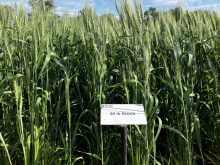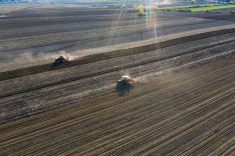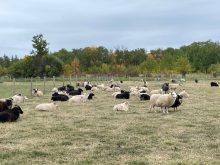Back some 30 years ago, I read that most of the wood ash produced in Canada for power and recovery boilers went to landfills, with less than three per cent for cropland application. Even today only 37 per cent is used as a cement addition, a neutralizing agent, a wood water treatment or wood stabilizer.
What a shame! Here’s a perfectly good organic source of lime, with plant macro- and micronutrients, being taken from the woodlands and virtually thrown away. Wood ash is an excellent source of magnesium, calcium, potassium, phosphate and micronutrients, which can very effectively raise up acid soil pH levels.
Inexpensive landfill sites are still available to wood ash producers in Canada — so the motivation to use this effective byproduct agriculturally is not there.
Read Also

Claas brings 1000 Series SP forage harvesters to Canada
In mid-August, Claas unveiled its new line of Jaguar forage harvesters at an event in Visalia, California, deep in the heart of that state’s dairy region.
This landfill disposal of wood ash flies in the face of agricultural sustainability. We talk a lot about sustainability and here we have a perfect example of misuse. Why not take this as a prime example of putting back much of the nutrients originally removed from agricultural or forest land? The most recent data I could find on the amount of wood ash was back some 12 years ago, in 2013. In that year it was given as 420,000 tons. If that were spread at two tons an acre on acidic cropland, it would cover some 210,000 acres. That’s only a small percentage of around six million acres of acidic cropland on the Prairies. Probably half of this wood ash was also produced in Eastern Canada.
Often red tape can get in the way of the agricultural or forestry use of wood ash. Bureaucrats may look at the soil test levels of the ash, see elements such as 13 p.p.m. (or milligrams per kilogram if you prefer) of arsenic or three p.p.m. of cadmium, and consider the wood ash as perhaps being toxic. They fail to realize virtually all soils contain detectable levels of lead, arsenic and mercury at variable levels — and when applied to cropland, these trace levels are of no consequence.
I remember some demonstration trials using wood ash or crushed limestone at around 2.5 tonnes an acre on acidic (pH 5) soils in northeastern Alberta in 2002-05. The four-year average yield for barley on the untreated land was 56 bushels an acre; land treated with lime, 78 bushels; and with wood ash, 84 bushels. For canola there were 23 in the control, 31 for lime and 37 bu./ac. for wood ash. Peas: 32 control, 48 lime, 50 wood ash. The researcher was Newton Lupwayi at Agriculture and Agri-Food Canada at Lethbridge.
So why are so many farmers looking this gift horse in the mouth? The value of nutrients per ton of wood ash, at 0.5 per cent P and three per cent K, would be enough to cover the cost of transport and application. At two tons an acre of wood ash you get 20 lbs. of P and 120 lbs. of K on average. Are we talking $100 or more of nutrients or more per application?

If you have acidic cropland, especially in many areas of Alberta, why not run trial strips of some 40-80 acres treated with two or three tons per acre with wood ash against the untreated acidic cropland? The effect of wood ash treatment has been shown to last as long as 20 years after application.
Specifically in Alberta, using 2002 data, around 180,000 tons of wood ash are produced annually. This wood ash is a byproduct of pulp mills, sawmills and board-making industries. Most of the wood ash at that time ended up in landfills.
In Canada we refer to acidic soils as those with a pH of 6.5 or less. Actually, an average 6.5 soil is a pretty good medium for virtually any crop grown in Prairie Canada. Problem acidic soils are those that are pH 5.5 or much less. At 5.5 or less, growing alfalfa is a waste of time and most legumes, including peas, beans and forage legumes, suffer significant yield losses. Grains, such as barley and wheat, also underperform at pH levels below 5.5.
Soil acidification is an ongoing process on cropland due to the use of nitrogenous fertilizers that increase soil acidity, lowering crop yields significantly in the more acidic soils.
Most micronutrients, though, are more available in acidic soils — with the exception of molybdenum. Using wood ash or lime to raise soil pH levels stabilizes molybdenum and makes it more plant-available. As is the case with lime application, wood ash reduces the acidity in the upper soil layers; it allows legumes to fix nitrogen more easily, and all crop plants to convert ammonia to nitrate and vice versa more effectively, due to the presence of available molybdenum.
Where I grew up in the U.K., a crop seed treatment of an ounce or so of a molybdenum compound per bushel was called the poor man’s lime. Farmers could not afford the cost of liming soil and this treatment made the molybdenum immediately available in acidic (pH of 4-5) soils. More than a few Alberta farmers on acidic soils treat their seed with an ounce or so of molybdenum per bushel.
My message to anyone farming in an area with available wood ash is “go for it” — even if your soil is neutral or only slightly acidic — since your cropland will benefit significantly from the added macro- and micronutrients. Dumping wood ash in landfills goes against every principle of cropland sustainability or “regenerative agriculture.” Applying the wood ash is merely returning the plant nutrients that were taken from that woodland— with the exception of most of the sulphur and nitrogen that are lost to the atmosphere in the burning process.
















